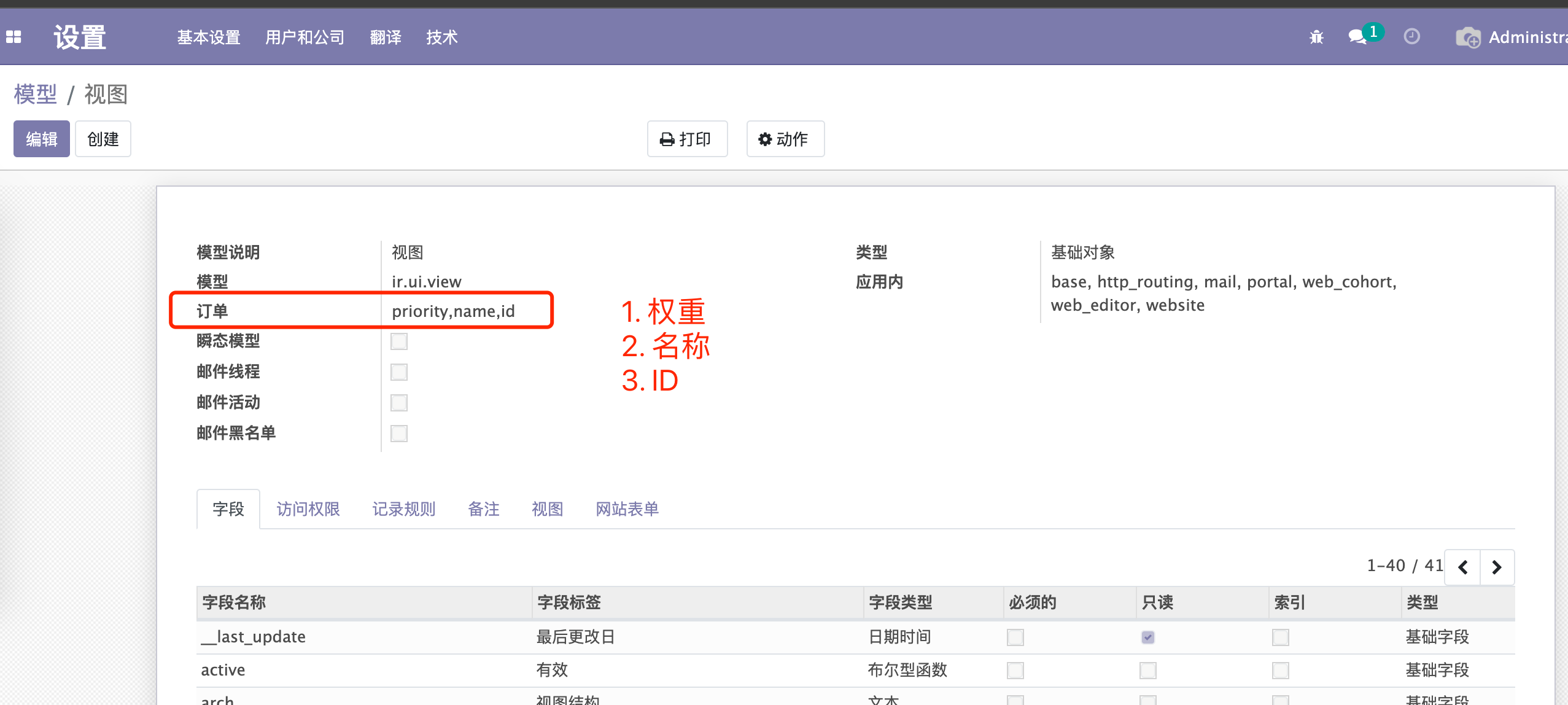【odoo】【知识点】视图的继承逻辑
背景:同一个模块,两组开发人员对同一个模型的form视图进行了二开。在没有指定外部ID的情况下,odoo是如何选择展示展示哪个视图呢?
上干货
- odoo在加载视图的时候,首先调用的models.py中的
load_views函数;
@api.model
def load_views(self, views, options=None):
""" Returns the fields_views of given views, along with the fields of
the current model, and optionally its filters for the given action.
:param views: list of [view_id, view_type]
:param options['toolbar']: True to include contextual actions when loading fields_views
:param options['load_filters']: True to return the model's filters
:param options['action_id']: id of the action to get the filters
:return: dictionary with fields_views, fields and optionally filters
"""
options = options or {}
result = {}
toolbar = options.get('toolbar')
result['fields_views'] = {
v_type: self.fields_view_get(v_id, v_type if v_type != 'list' else 'tree',
toolbar=toolbar if v_type != 'search' else False)
for [v_id, v_type] in views
}
result['fields'] = self.fields_get()
if options.get('load_filters'):
result['filters'] = self.env['ir.filters'].get_filters(self._name, options.get('action_id'))
return result
- 上面的核心在
fields_view_get函数,如下,截取重要的内容
@api.model
def fields_view_get(self, view_id=None, view_type='form', toolbar=False, submenu=False):
self.check_access_rights('read')
view = self.env['ir.ui.view'].sudo().browse(view_id)
# Get the view arch and all other attributes describing the composition of the view
result = self._fields_view_get(view_id=view_id, view_type=view_type, toolbar=toolbar, submenu=submenu)
···
- 检查权限通过后,调用
_fields_view_get函数,若用户调用的视图没有指定视图ID,那么将调用默认的视图
@api.model
def _fields_view_get(self, view_id=None, view_type='form', toolbar=False, submenu=False):
View = self.env['ir.ui.view'].sudo()
result = {
'model': self._name,
'field_parent': False,
}
# try to find a view_id if none provided
if not view_id:
# <view_type>_view_ref in context can be used to overrride the default view
view_ref_key = view_type + '_view_ref'
view_ref = self._context.get(view_ref_key)
if view_ref:
if '.' in view_ref:
module, view_ref = view_ref.split('.', 1)
query = "SELECT res_id FROM ir_model_data WHERE model='ir.ui.view' AND module=%s AND name=%s"
self._cr.execute(query, (module, view_ref))
view_ref_res = self._cr.fetchone()
if view_ref_res:
view_id = view_ref_res[0]
else:
_logger.warning('%r requires a fully-qualified external id (got: %r for model %s). '
'Please use the complete `module.view_id` form instead.', view_ref_key, view_ref,
self._name)
if not view_id:
# otherwise try to find the lowest priority matching ir.ui.view
view_id = View.default_view(self._name, view_type)
if view_id:
# read the view with inherited views applied
root_view = View.browse(view_id).read_combined(['id', 'name', 'field_parent', 'type', 'model', 'arch'])
result['arch'] = root_view['arch']
result['name'] = root_view['name']
result['type'] = root_view['type']
result['view_id'] = root_view['id']
result['field_parent'] = root_view['field_parent']
result['base_model'] = root_view['model']
else:
# fallback on default views methods if no ir.ui.view could be found
try:
arch_etree = getattr(self, '_get_default_%s_view' % view_type)()
result['arch'] = etree.tostring(arch_etree, encoding='unicode')
result['type'] = view_type
result['name'] = 'default'
except AttributeError:
raise UserError(_("No default view of type '%s' could be found !", view_type))
return result
- 此处我们讨论的是odoo是如何取默认视图的,再进ir.ui.view模型的
default_view函数查看
@api.model
def default_view(self, model, view_type):
""" Fetches the default view for the provided (model, view_type) pair:
primary view with the lowest priority.
:param str model:
:param int view_type:
:return: id of the default view of False if none found
:rtype: int
"""
domain = [('model', '=', model), ('type', '=', view_type), ('mode', '=', 'primary')]
return self.search(domain, limit=1).id
- 是不是很惊喜,毛都没有,看不出来如何做的选择。别着急,看ir.ui.view的模型吧。

有点坑啊,大家在视图继承的时候。权重基本上是默认的,也就是说若不考虑name的影响,那么默认视图将永远是最先添加的基础视图。但是,这里name的排序居然还在ID的前面,这就有的玩了嘛,起名字也是门艺术了。
- 好了回归正题,在步骤3中,拿到了默认视图后,我们取到的视图有可能是继承视图,也有可能是基础视图。那么将通过
read_combined函数拼接出来以基础视图为框架,包含所有继承视图内容的etree对象。
def read_combined(self, fields=None):
"""
Utility function to get a view combined with its inherited views.
* Gets the top of the view tree if a sub-view is requested
* Applies all inherited archs on the root view
* Returns the view with all requested fields
.. note:: ``arch`` is always added to the fields list even if not
requested (similar to ``id``)
"""
# introduce check_view_ids in context
if 'check_view_ids' not in self._context:
self = self.with_context(check_view_ids=[])
check_view_ids = self._context['check_view_ids']
# if view_id is not a root view, climb back to the top.
root = self
while root.mode != 'primary':
# Add inherited views to the list of loading forced views
# Otherwise, inherited views could not find elements created in their direct parents if that parent is defined in the same module
check_view_ids.append(root.id)
root = root.inherit_id
# arch and model fields are always returned
if fields:
fields = list({'arch', 'model'}.union(fields))
# read the view arch
[view_data] = root.read(fields=fields)
view_arch = etree.fromstring(view_data['arch'].encode('utf-8'))
if not root.inherit_id:
if self._context.get('inherit_branding'):
view_arch.attrib.update({
'data-oe-model': 'ir.ui.view',
'data-oe-id': str(root.id),
'data-oe-field': 'arch',
})
arch_tree = view_arch
else:
if self._context.get('inherit_branding'):
root.inherit_branding(view_arch)
parent_view = root.inherit_id.read_combined(fields=fields)
arch_tree = etree.fromstring(parent_view['arch'])
arch_tree = self.browse(parent_view['id']).apply_inheritance_specs(arch_tree, view_arch)
# and apply inheritance
arch = root.apply_view_inheritance(arch_tree, self.model)
return dict(view_data, arch=etree.tostring(arch, encoding='unicode'))
结束
【odoo】【知识点】视图的继承逻辑的更多相关文章
- 关于类视图选择继承APIView还是工具视图(ListAPIView、CreateAPIView等等)
APIView使用方法,直接继承APIView,get或者post请求.方法很简单1.先获取到要操作的数据,然后把数据放到serializer中序列化或者反序列化,最后return返回值(记得.dat ...
- ODOO里视图开发案例---定义一个像tree、form一样的视图
odoo里视图模型MVC模式: 例子:在原来的视图上修改他: var CustomRenderer = KanbanRenderer.extend({ ....});var CustomRendere ...
- Odoo中的模型继承、视图继承、Qweb模板继承详解
转载请注明原文地址:https://www.cnblogs.com/ygj0930/p/10826114.html 在实际开发过程中,经常会遇到需要修改Odoo原生逻辑的情况.然而,直接修改Odoo底 ...
- 第八章 Odoo 12开发之业务逻辑 - 业务流程的支持
在前面的文章中,我们学习了模型层.如何创建应用数据结构以及如何使用 ORM API 来存储查看数据.本文中我们将利用前面所学的模型和记录集知识实现应用中常用的业务逻辑模式. 本文的主要内容有: 以文件 ...
- 解读ASP.NET 5 & MVC6系列(16):自定义View视图文件查找逻辑
之前MVC5和之前的版本中,我们要想对View文件的路径进行控制的话,则必须要对IViewEngine接口的FindPartialView或FindView方法进行重写,所有的视图引擎都继承于该IVi ...
- Odoo form视图详解
转载请注明原文地址:https://www.cnblogs.com/ygj0930/p/10826350.html 一:Header头部 header区域一般用于展示文档流转的阶段和生命周期,以及动作 ...
- 自定义视图(继承View)
前言 Android提供了丰富的控件,但是有时候还是不能满足自己的需求,这时候就需要自定义视图了,自定义视图分为几种,一种为继承为View的,一种为继承于ViewGroup的.继承于View的需要我们 ...
- 自定义控件(视图)2期笔记09:自定义视图之继承自ViewGroup(仿ViewPager效果案例)
1. 这里我们继承已有ViewGroup实现自定义控件,模拟出来ViewPager的效果,如下: (1)实现的效果图如下: (2)实现步骤: • 自定义view继承viewGroup • 重写onLa ...
- 12.Yii2.0框架视图模版继承与模版相互调用
目录 模板渲染的两种方式 加载视图 index.php 和 about.php 页面 建立控制器HomeController php 新建模板 home\index.php 新建模板home\abou ...
随机推荐
- 一起来看Java设计思想之23种设计模式
目录 怎么使用设计模式 23种设计模式 创建型模式 结构型模式 行为型模式 总结 怎么使用设计模式 为什么要使用设计模式? 编写代码,写接口.写类.写方法 用设计模式做设计的作用是什么? 指导.规定如 ...
- 为什么有时博客中的代码复制进自己的VS中报错
昨天写代码时遇到一个问题,我搜了一篇博客,然后复制到我的WPF中, 然后,全报错(当时快给我气死了,一篇有一篇的不能用,试了一次又一次,时间全浪费在这上面了,没打游戏,做的东西也没出来) 问题原因: ...
- Linux安装MySQL8高版本压缩包(通用)
前言 前段时间领导让我部署测试环境,希望安装高版本的MySQL,过程遇到很多问题,特此记录帮助迷失的人们 下载 MySQL官方下载地址:https://dev.mysql.com/downloads/ ...
- 【Nginx(二)】Nginx目录结构和常用的命令以及核心配置文件
Nginx的目录结构: 默认的安装路径 : /usr/local/nginx 安装完成后,Nginx的目录结构如下: conf: #所有配置文件的目录 nginx.conf #默认的主要配置文件 ...
- Thinkphp5之laypage分页插件的实现
//一下是laypage所用到的 js <script type="text/javascript" src="__STATIC__/lib/laypage/1.2 ...
- MetaWeblog访问地址
MetaWeblog访问地址 https://rpc.cnblogs.com/metaweblog/csnd
- POJ3114强连通+spfa
题意: 给你n个点,m条有向边,q询问,每次询问给两个数a,b输出a->b的最短路,但是题目有个限制,就是在一个环上的任意两点距离为0. 思路: 简单题目,直接强连通压缩 ...
- Python中Scapy网络嗅探模块的使用
目录 Scapy scapy的安装和使用 发包 发包和收包 抓包 将抓取到的数据包保存 查看抓取到的数据包 格式化输出 过滤抓包 Scapy scapy是python中一个可用于网络嗅探的非常强大的第 ...
- Python练习3-XML-RPC实现简单的P2P文件共享
XML-RPC实现简单的P2P文件共享 先来个百度百科: XML-RPC的全称是XML Remote Procedure Call,即XML(标准通用标记语言下的一个子集)远程过程调用.它是一套允许运 ...
- anaconda安装教程
Anaconda是一个方便的python包管理和环境管理软件,一般用来配置不同的项目环境.我们常常会遇到这样的情况,正在做的项目A和项目B分别基于python2和python3,而第电脑只能安装一个环 ...
